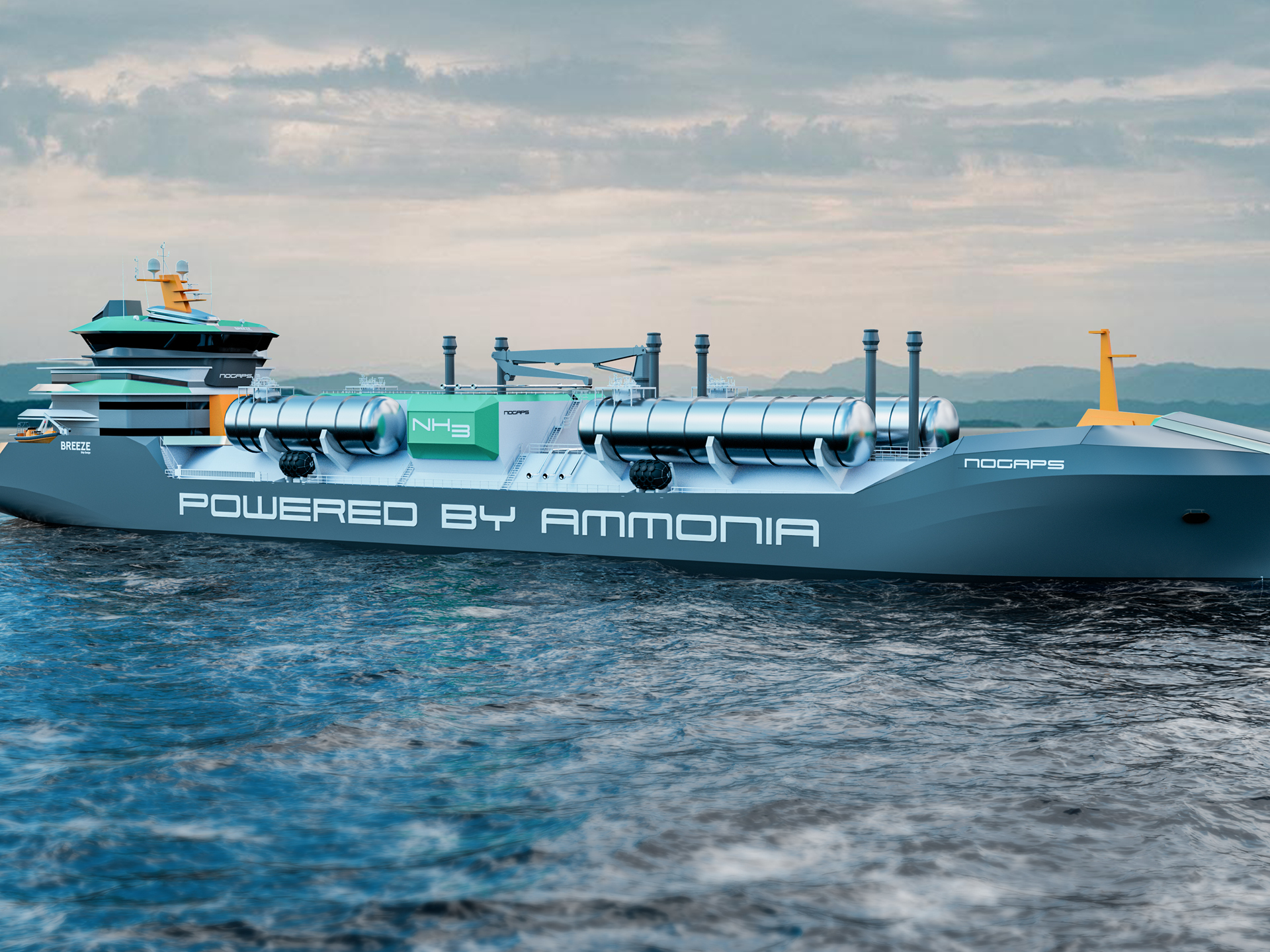Executive Summary
Co-funded by Nordic Innovation
Ammonia is a promising alternative marine fuel. However, there are currently no ships capable of sailing on ammonia. The Nordic Green Ammonia-Powered Ships (NoGAPS) project brings together key players in the value chain to develop solutions for a Nordic-based, ammonia-powered, zero-emission ship.
The first phase was publicly funded with private in-kind contributions, included members from across the value chain, and all results were made public. The second phase, which is currently in progress, uses public and private co-funding with a narrowing focus on the design, operation, and economics of an ammonia-fueled vessel. The M/S NoGAPS is a handy-sized ammonia-fueled gas carrier (22,000 m3 cargo capacity) optimized for commercial operation in the North Atlantic and northwestern European waters.
NoGAPS 2, the second phase of the NoGAPS project, involves producing an initial ship design that will lay the foundation for a shipyard tender and the potential construction of the vessel. The Mærsk Mc-Kinney Møller Center for Zero Carbon Shipping (MMMCZCS) is leading the vessel design work for NoGAPS 2 in close collaboration with project partners and an external ship designer. The design follows an open innovation process to capture the best engineering practices around configuring the new design for ammonia fuel, best practices relating to safety standards and safeguards in design, energy efficiency, and choice of technologies. This report summarizes the results and findings from the feasibility assessment conducted as the first step of NoGAPS 2. The feasibility assessment identifies and evaluates ship design concepts that can achieve the design objectives and requirements. This high-level assessment is intended to evaluate the main design considerations, including the general arrangement and machinery configuration.
Design objectives for the M/S NoGAPS were defined based on conclusions from NoGAPS 1. The main objective of the NoGAPS 2 vessel design is to confirm that no major technical or regulatory obstacles are present. The design should also demonstrate a credible business model focusing on reducing risk and cost, while maintaining acceptable safety levels and fulfilling design requirements.
When using ammonia as a fuel, there are challenges, hazards, and opportunities that should be considered during the ship design process, including the properties of ammonia and their effects on human health and the environment, flammability, explosiveness, and corrosion. These considerations were incorporated in our feasibility assessment in addition to using DNV Rules and the IGC Code as the regulatory basis for the project. Close collaboration and discussion with class and flag administrations are also needed, as the IGC Code currently does not permit the use of cargoes identified as toxic products like ammonia to be used as fuel. There is an opportunity, however, to seek acceptance by the flag administration by justifying equivalent levels of safety by using a risk-based alternative design process.
Two main machinery configurations were also assessed as part of the feasibility phase – an ammonia-electric propulsion system with four-stroke (4S) main engines and an ammonia-mechanical solution with a two-stroke (2S) main engine. Our assessment of the machinery configurations concluded with selecting the 2S option. This was mainly driven by the lower fuel consumption and reduced emissions for the 2S option. The 2S configuration also contributes to a simplified safety concept with a single ammonia consumer onboard that maximizes the emission reduction potential of ammonia as a fuel.
In addition to the two main design considerations for the feasibility phase related to accommodation location and machinery configuration, other design aspects were also evaluated, including fuel tank location and dimensioning, bunkering capability, and ship stability.
We have concluded that further studies on the vessel’s bunkering capability, including installing a bow thruster, are needed as it presents a flexible option for the vessel’s owner. Also, the main engine will be the only ammonia consumer with auxiliary engines and boiler, if needed, being fueled by conventional or biofuels.
The project has now entered the initial design phase to incorporate the key decisions and outcomes from the feasibility phase and increase the level of detail and analysis. This includes kicking off the initial design development, a hazard identification (HAZID) qualitative risk assessment workshop, optimization of vessel efficiency, submission of design drawings and documentation to target an approval in principle from DNV, and, finally, an initial design package that can be used for submission to shipyards for official tenders.
Ammonia-fueled engines, ammonia fuel supply systems, and emission abatement technologies are still in the early development stages. For the NoGAPS project, the design assumptions related to fuel consumption, pilot fuel amount and other performance related values are to be considered expected or target values. As the design development progresses, continuous alignment with results from the technology and system development will be critical to ensure an optimal final ship design concept.
